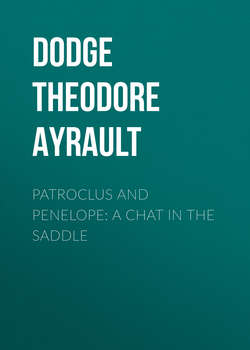Читать книгу Patroclus and Penelope: A Chat in the Saddle - Dodge Theodore Ayrault - Страница 7
VI
ОглавлениеThe fancy of to-day is for the daisy-clipping thoroughbred. And when they do not run to the knife-blade pattern, they may be the finest mounts a man can throw his leg across. But my fancy for the road has always been for the higher stepping half-bred. Granted that on the turf or across a flying country blood will tell. Granted that brilliant knee action is mainly ornamental. Still, in America, the half-bred will average much better in looks, and vastly more satisfactory in hardy service. Where shall we again find the equivalent of the Morgan breed, now all but lost in the desire to get the typical running horse? For saddle work, and the very best of its kind, there was never a finer pattern than the Morgan. Alas, that we have allowed him to disappear! His worth would soon come to the fore in these days of saddle pleasures. The thoroughbred's characteristic is ability to perform prodigies of speed and endurance at exceptional times. But the strong, every-day-in-the-year good performer is usually no more than half-bred, if even that. Moreover, you can find a hundred daisy-clippers for one proud stepper, be he thoroughbred or galloway. There is such a thing as waste of action. No one wants to straddle a black Hanoverian out of a hearse. But the horse who steps high may be as good a stayer as the one who does not, and high action is a beauty which delights men's eyes and opens their purses. Because the long stride of the turf is better for being low, it is not safe to apply this rule to the road.
There are many more worthless brutes among thoroughbreds than among the common herd. While it is easy to acknowledge that the perfect thoroughbred excels all other horses, the fact must also be noted that he is of extremest rarity, and even when found is infrequently up to weight. If we use the word advisedly, only the horse registered in the Stud Book is a thoroughbred. These have no early training whatever, except to allow themselves to be mounted, and to run their best. If they stand the initial test of speed, they are reserved for the turf, and there wholly spoiled for the saddle or for any other purpose of pleasure. If they do not, they are turned adrift, half spoiled in mouth and manners by tricky stable-boys, and may or may not fall into good hands. For one thoroughbred with perfect manners, sound, and up to weight, there are a score of really good half-breds, as near perfection as their owners choose or are able to make them.
What we in America are apt colloquially to call a thoroughbred is only a horse which, in his looks, shows some decided infusion of good blood, or is sired by a well-bred horse. But it is to be remembered that of two horses with an equal strain of pure blood, one may have reverted to a coarse physical type, and the other to the finer. And the one who has inherited the undeniable stamp of the common-bred ancestor may also have inherited from the other side those qualities of constitution, courage, intelligence, and speed, which sum up the value of high English blood. Not one fine-bred horse in one hundred – I speak from the ownership of, and daily personal intimacy for considerable periods with, over fifty good saddle beasts, – has as many of the admirable qualities of pure blood as Patroclus. And yet (absit omen), he has a wave in his tail, and though his feet and legs are perfect in shape, and as clean as a colt's, they are far beyond the thoroughbred's in size. He shows that his ancestry runs back both to the desert and the plough. In America, surely, handsome is that handsome does. Let us value good blood for its qualities, not looks, and ride serviceable half-breds, instead of sporting worthless weeds because they approach to the clothes-horse pattern, or have necks like camels.
